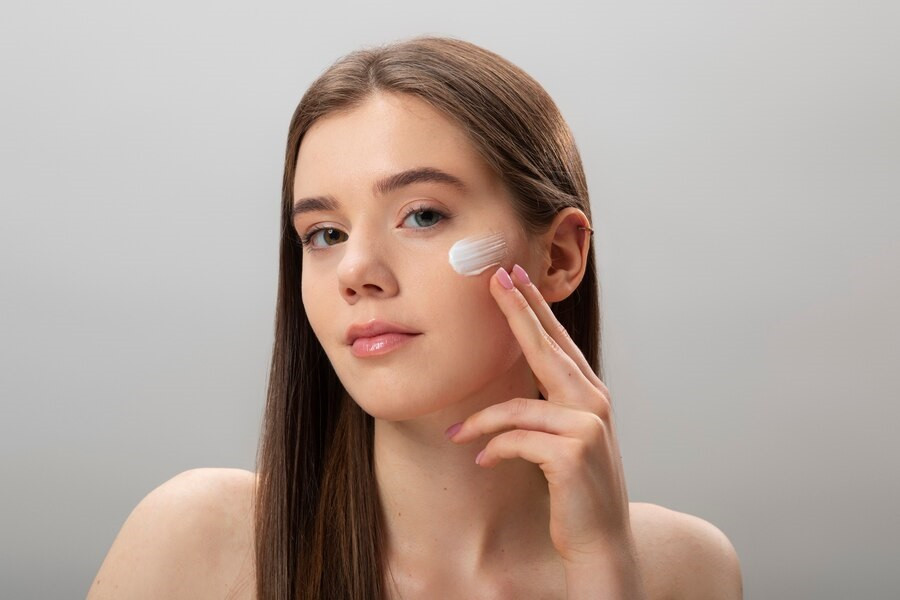Tabir surya atau sunscreen dibutuhkan setiap orang untuk melindungi kulit dari paparan sinar UV yang berbahaya. Sinar UV dapat merusak kulit, meningkatkan risiko kanker kulit serta penuaan dini.
Ada dua jenis tabir surya yang saat ini banyak beredar di pasaran. Perbedaan utama dari kedua jenis ini ada pada cara kerja dan bahan yang digunakan. Ketahui mana jenis tabir surya yang cocok sesuai dengan kondisi kulit Anda.
Apa Itu Tabir Surya?
Tabir surya atau yang juga dikenal sebagai sunscreen adalah produk yang digunakan untuk melindungi kulit dari paparan sinar matahari, terutama sinar ultraviolet dari sinar matahari. Pemakaian tabir surya secara rutin bisa membantu menjaga barrier pelindung kulit, mengurangi risiko kanker kulit, membantu mencegah penuaan dini dan masalah kulit lainnya yang disebabkan oleh paparan sinar UV.
Tabir surya melindungi kulit dengan cara menyerap atau memantulkan sinar UV sehingga tidak sampai masuk ke dalam kulit dan merusak sel-sel kulit kita. Dengan demikian, tanda penuaan dini seperti bintik-bintik kecokelatan, garis halus dan kerutan kulit bisa dicegah.
Tabir surya biasanya mengandung bahan aktif seperti zinc oxide, titanium dioxide, avobenzone, oxybenzone, octinoxate atau campuran bahan lain yang aman dan bisa melindungi kulit dari sinar UVA dan UVB. Tabir surya disarankan untuk dipakai setiap hari, khususnya bila akan pergi ke luar ruangan dan terpapar sinar matahari baik saat terik maupun cuaca mendung.
Baca Juga: Tanda-Tanda Jika Anda Alergi Tabir Surya
Jenis-Jenis Tabir Surya
Tabir surya memiliki SPF (Sun Protection Factor) atau Faktor Pelindung Matahari. SPF menggambarkan kemampuan tabir surya dalam melindungi kulit dari sinar UVB. Dengan memakai tabir surya yang memiliki SPF tinggi, Anda bisa mengurangi paparan sinar matahari yang berbahaya pada kulit secara signifikan.
Baca Juga: Lebih Baik Mana, Tabir Surya SPF 30, SPF 50, atau SPF 100?
Secara umum ada dua jenis tabir surya yang dibedakan berdasarkan bahan dan cara kerjanya, di antaranya:
Tabir surya fisik
Tabir surya fisik disebut juga physical/mineral sunscreen. Tabir surya ini bekerja dengan cara menciptakan lapisan penangkal fisik di atas kulit yang memberikan perlindungan terhadap sinar matahari.
Biasanya tabir surya fisik terbuat dari bahan-bahan seperti zinc oxide atau titanium dioxide yang dinyatakan aman untuk digunakan sebagai bahan tabir surya. Bahan-bahan ini bekerja dengan cara memantulkan radiasi sinar UV sebelum sinar tersebut mencapai permukaan kulit. Selain itu, tabir surya yang mengandung zinc oxide atau titanium dioxide juga kecil kemungkinannya dalam menyebabkan iritasi pada kulit yang sensitif.
Tabir surya kimia
Tabir surya kimia disebut juga chemical sunscreen. Cara kerjanya berbeda dengan tabir surya fisik. Jenis tabir surya ini mengandung molekul berkarbon seperti avobenzone, oxybenzone, octinoxate yang menyerap sinar ultraviolet sebelum sampai ke kulit. Proses ini membantu mencegah sinar UV merusak sel-sel kulit.
Biasanya tabir surya kimia cenderung lebih ringan dan tidak meninggalkan bekas berwarna putih di kulit (white cast). Namun, pada beberapa orang, bahan kimia yang digunakan dalam tabir surya kimia dapat menimbulkan reaksi kulit, khususnya pada mereka yang memiliki jenis kulit sensitif.
Memilih tabir surya yang tepat bergantung pada banyak faktor seperti jenis kulit, masalah kulit yang dimiliki, dan juga preferensi pribadi. Apabila Anda memiliki masalah kulit atau alergi terhadap bahan kimia tertentu, sebaiknya berkonsultasi terlebih dahulu dengan dokter atau ahli dermatologi sebelum memilih tabir surya.
Anda bisa memanfaatkan layanan konsultasi kesehatan dengan dokter sebelum memilih tabir surya melalui aplikasi Ai Care yang bisa diunduh di App Store atau Play Store.
Mau tahu tips dan trik kesehatan, pertolongan pertama, dan home remedies lainnya? Cek di sini, ya!
- dr Hanifa Rahma
Cleveland Clinic (2023). Yes, You Should Wear Sunscreen Every Day. Available from: https://health.clevelandclinic.org/why-you-should-wear-sunscreen-every-day
John Hopkins Medicine. Sunscreen and Your Morning Routine. Available from: https://www.hopkinsmedicine.org/health/wellness-and-prevention/sunscreen-and-your-morning-routine
American Academy of Dermatology Association (2023). Sunscreen FAQS. Available from: https://www.aad.org/media/stats-sunscreen
Jessica Timmons (2022). What’s the Difference Between Physical and Chemical Sunscreen?. Available from: https://www.healthline.com/health/physical-vs-chemical-sunscreen
Chemical Safety Facts.org (2023). Sunscreen: Chemical Ingredients and Summertime Safety. Available from: https://www.chemicalsafetyfacts.org/health-and-safety/sunscreen-chemical-ingredients-and-summertime-safety
Comisian Europea. Zinc oxide (nano form). Available from: https://ec.europa.eu/health/scientific_committees/opinions_layman/zinc-oxide/es/l-2/6.htm
Chemical Safety Facts.org (2023). Titanium Dioxide. Available from: https://www.chemicalsafetyfacts.org/chemicals/titanium-dioxide/
Logan Smith (2022). How to Find Sunscreens Without a White Cast. Available from: https://www.webmd.com/beauty/how-to-find-sunscreens-without-a-white-cast












